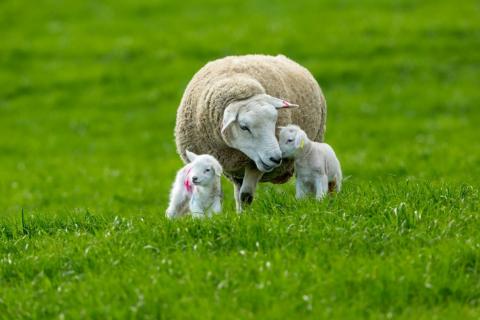17 July 2020
Dr David Cutress: IBERS, Aberystwyth University.
- Sheep farming globally supplies 3 – 4 % of red meat production with the potential to have an increasing role in future due to sheeps’ natural climate adaptability
- Currently, significant flock productivity losses occur across the sector reducing the profitability of sheep production worldwide
- Certain management strategies and technologies may have the potential to improve flock productivity towards increasing sector profitability
Introduction
Sheep farming is an important industry for the production of red meat, as well as wool and milk products. In the UK approximately 34 million sheep are present within the sector producing 288,600 tons of meat, with around 63,000 tons of this coming directly from the ~10 million sheep present within Wales. Globally the number of sheep is around 1.2 billion with China, Australia and India representing the three highest international inputs with 164 million, 70 million and 61 million sheep stocks respectively (FAO 2018). As such the sheep industry provides a small but essential percentage of meat (3 - 4% global total) and other resources for an ever-growing population. Furthermore, sheep have far greater adaptability to varied climates and can utilise land unfavourable to many other agricultural activities and thus, could prove increasingly vital in the future considerations of climate change and optimal land use. For the UK and many other countries, the sheep sector acts as a major economic asset through both produce yields and the careers associated. However, the cost-efficiency of sheep farming can be very low, achieving minimal returns on investments, with average cull ewe prices of £61 per head, store lamb prices of £56 per head and finished lamb prices of 193 pence/kg (based on 5-year averages from 2019). Alongside lower sale prices, (due to public demand for value and competition from intensive rearing systems such as India and China) the costs of raising sheep (including feed, pasture management and housing) and farm labour costs have led to generally negative net margins, with reliance on other contributions such as the basic payment scheme. Despite this, the top UK producers can achieve far greater profits than the lowest-achieving producers suggesting that higher production efficiencies can be achieved to improve sheep farming profitability on the whole, whilst concurrently improving long term sustainability. Some factors which are associated with improved revenue efficiency include; stocking rates, pasture quality, pasture management, reproductive performance/management and disease management to name just a few.
Reproduction
High mortality during pregnancy and lambing is a key issue with the average UK mortality rates estimated to be between 15 - 20%. This represents huge production losses across the industry with previous suggestions that during pregnancy alone (disregarding high losses following lambing) these cost £20 -25 per lamb and as such, this is an area where large cost efficiency gains could be made. Factors which affect lamb mortality include pregnant ewe nutrition or bodyweight, trauma at birth, bonding of ewe and lamb, diseases and external factors such as predation. Whilst the previous factors are known to be involved, the true representation of individual factor effects on farms is difficult to assess, as accurate recordings of deaths (post mortem information) and treatments made by farmers during the busy lambing period (which often coincides with a busy time of year generally) can be hard to achieve, though Welsh programmes have gained insights in the past. Where recordings have been performed and assessed it has been shown that farmers which actively and regularly engaged tended to gain an increased understanding of the specific factors which required management changes on their farms, and this could help to negate the trend of underestimating the true level of production losses associated with lamb mortality. Improving lambing management and understanding factors with true beneficial effects has repeatedly been demonstrated to be hampered by a lack of data collection as such one tool which could act to improve this is the regular use of recording software (for example Sheep Manager) which could benefit from further integration of precision livestock technologies to achieve automation reducing the labour and time burdens involved.
In systems where ewe health and nutrition are high and farm environment and feed availability are not a concern (largely lowland systems which are less common in Wales) there has been a clear productivity gain to be found in having higher litter sizes. Research has suggested pregnancy-specific protein B (PSPB) commercial kits have potential as a low-cost method of screening ewes for twins and triplets, facilitating optimised management with increased feeds for the successful weaning of increased lamb numbers even in lower nutritionally efficient extensive grazing systems. Despite evidence that litter sizes of triplets or higher decreases lamb survival (due to mismothering and starvation), increasing lamb litters towards increased twins rather than singles has been suggested to be achievable given optimal pasture/nutritional management and demonstrated significant increases in profits relating to higher total lamb ouputs. When considering hill and upland systems decreasing lambing intervals has been demonstrated to have benefits, with a study in the Swiss alps using an accelerated breeding programme model demonstrating 57% improvements in income per hectare despite the increased labour costs associated with multiple lamb rearing periods. This study also noted that in a traditional once per year breeding system increasing litter sizes could be economically beneficial in upland/hill systems. Whilst sheep are usually seasonal breeders, accelerated breeding and ewe lamb breeding, can both increase the pool of reproductively available ewes and total lamb output. Other cost benefits achieved through year-round breeding include the spread of income through the year, spreading any poor productivity risks and also tapping into high price markets (such as Jan-Feb high sale prices when spring lambing misses this timescale). However, accelerated breeding is not without challenges, with difficulties in effectively achieving breeding during the anoestrus periods. The current practices for achieving this include hormone treatments (melatonin, progesterone and equine chorionic gonadotrophin), photoperiod control and more recently studies are looking at specific genes controlling this process. Despite accelerated breeding leading to reduced pregnancy rates the increased number of opportunities to breed throughout the year leads to an increase in lambs born overall and thus higher production rates within a system.
Breeding and genomics
The goal other than improved production and profitability within livestock, and sheep sectors generally, is to move towards increased sustainability. It is interesting to note, that the last 40 years of selective breeding towards improving sheep breed genetic merits in the UK has recently been demonstrated to have increased the net energy intake requirements across Texel, Highlander, Belclare and Lleyn crossbreeds by around 40%. This suggests a clash between traditional breeding methods for improved flock performance and reducing feed inputs for a sustainable future. If such trends are continued this could be detrimental to overall cost efficiency unless subsequent gains are made in optimising nutrient input efficiency. Conversely there has also been a shift in recent breeding regimes towards lower maintenance easy-care sheep breeds which have multiple benefits including reduced lamb mortality and increased ratio of twin to single lambs born in order to increase overall productivity.
Within the sheep industry selecting for traits which could improve reproductive efficiency in any form could have major production efficiency effects, however, these traits have demonstrated low heritabilities to date. Genetic selection using estimated breeding values (EBVs) is common but can be slow and fraught with difficulties due to multiple variables which can influence the same production response, as well as both dam and sire influences requiring consideration. Due to interest in increasing flock output and performance, quantitative trait loci (QTL) technologies were initially utilised to map gene regions of interest to animal performance traits in livestock such as bodyweight or reproductive performance. More recently, however, improvements in speed and cost of whole-genome technologies in the form of Genome-wide associated study (GWAS) are helping to fill the gaps in gene functionality. Several genes are being identified for their roles in sheep growth and bodyweight (including LIM Homeobox (LHX) 3 and 4 and ovine Calpain) as well as genes involved in meat and carcass quality (including myostatin variants and the diacylglycerol acyltransferase 1 gene) and genes associated with reproduction traits including ovulation rate, litter size, percentage of stillbirth and age at first lambing (including bone morphogenetic protein receptor IB and growth differentiation factor-9). Whilst these provide little direct utilisation to farmers, they could hold huge potential in genetic improvement programmes utilising breeding tools such as in-vitro fertilisation (IVF) and direct genetic modification in the future.
Stocking
Increased stocking appears to be a simple way to increase productivity, however, this leads to increasing labour, associated increases in infectious diseases and potentially insufficient nutrition unless combined with pasture improvements or higher input costs and environmental impacts associated with non-forage feeds. Therefore, stocking levels require careful balancing dependent on the resource availability of each farm scenario. Higher stocking rates have been demonstrated to have negative impacts on the already high lamb mortality levels in certain studies, with a recent Australian study (across 88 producers) finding decreased lamb survival per extra 100 ewes in a mob. In a recent comprehensive economic model based on data from a 20 ha plot in Ireland with increasing stocking rates and increasing litter sizes, it was demonstrated that input costs of concentrate feed, labour and veterinary inputs increased, as would be expected due to higher sheep numbers. Increasing input costs and lower profits per lamb (due to higher stocking and higher litter sizes leading to smaller slower growing lambs) were detrimental to net profits but only when pasture management remained static. If grass grown or grass utilised was increased (between 15 - 40% and 22 - 60% respectively) the increase in lambs weaned per hectare increased net profits across all scenarios, with more than double the profits achievable when the highest pasture improvement and stocking rates were combined. This demonstrates the complexity and scenario specificity surrounding stocking rates as well as the importance of pasture management on flock output.
Pasture management and nutrition
Correct nutrition is vital for a healthy high performing sheep flock. Nutrition influences effective breeding, reproductive success and productivity, health, immunity, disease occurrence, weight gain and specific product quality factors (meat, milk, wool). Where nutrition is concerned the production system applied is key, with extensive grazing or intensive systems having entirely different nutritional considerations. Intensive systems are more reliant on non-forage feed, these feeds have the benefit of being able to be analysed for exact nutritional value (either in labs or via handheld technologies on-farm) but often have associated higher costs. Also when considering climate impact and sustainability non-forage feeds which are partly grain-based are in direct competition for their potential application in human nutrition, though this only accounts for around 13% of the global livestock feed input. As such improving nutritional gain with reduced costs and environmental impacts including the use of antibiotics is key and has previously been targeted by a European Innovation Partnership project in Wales. Genetic improvements in livestock themselves is not the only route, as genetic improvement of pasture forages have also demonstrated gains towards improved production, providing increasing dry matter and improved feed availability during previously low forage availability periods. This enables reductions in supplementary feeds and associated costs over winter and allows potentially increased stocking rates. Furthermore, specific breeding has enabled targeted nutritional benefits such as high Proanthocyanidin expressing white clover, lucerne or alfalfa species (to enhance ruminant protein utilisation and reduce bloat) and improved digestibility/increased lipid content ryegrasses (to improve energy intakes and production gains). Such enhanced species could further be incorporated into mixed-species leys to provide multiple environmental, animal nutrition and animal health benefits.
Specific dietary supplementations can also play a role in improving flock productivity. Dietary undigestible proteins/rumen undegradable proteins (DUP/RUP) such as treated soya products have been researched for their role in increasing nutrient utilisation in ruminants. Studies have suggested increases in feed intake, growth rate, feed efficiencies and survival in lambs as well as higher birth weights of lambs and colostrum IgG yields and concentrations from ewes supplemented with DUP in feed. Nutrition, particularly in the transition period during late pregnancy, can also play a key role in the productivity of a sheep system. In this period (pre-lambing) there is time to tweak nutritional inputs to maximise health and survival of both ewes and lambs born with metabolic profiling acting as an important management tool. This is one of the methods being utilised by Farming Connect demonstration farm, Glanmynys to ensure their sheep flocks maintain a healthy body condition score which is linked to improved reproductive success, improved lamb survival and improved lamb productivity (such as daily weight gain) towards a more profitable enterprise.
Other tools for improving pastures include stock management tools improving utilisation of dry matter yields for facilitating livestock grazing and nutrition (such as Precision Grazing Ltd and PastureBase). Grazing management systems utilise data input by farmers relating to pasture cover across farms and can estimate livestock numbers individual paddocks can support, assisting in optimal productive management. Other precision technologies including soil mapping and variable-rate nutrient application can further improve pasture performance to facilitate improved livestock dry matter availability and nutrition. With tools such as automated weighing having been demonstrated to act as a low labour opportunity to manage nutrition in a more targeted controlled way and even act as a disease indication tool. In an analysis of 648 UK sheep farms surveyed, farms which weighed lambs during lactation had increased productivity and sheep flock performance compared to those who failed to do this, suggesting further potential for automated weighing as a key productivity tool.
Disease
Disease losses are a key area of flock performance loss in the UK with the major endemic sheep diseases being gastrointestinal (GI) parasites, scab, footrot, various types of abortions and toxoplasmosis. Previous estimations of the annual costs of these diseases are £84 million, £8 million, £24 million, £20 million and £12 million respectively, therefore, any strategies to reduce disease can improve industry profitability massively. Furthermore, multiple studies have highlighted the increased prevalence of livestock diseases concerning climate change, as such the control of diseases plays an increasingly important role in flock performance. An increasing concern is also present regarding sub-clinical disease impacts on the productivity of sheep enterprises. These lower-level sustained conditions often referred to as iceberg diseases, have yet to be comprehensively assessed for their full impact on flock performance and productivity but have been linked with reduced productivity, increased costs and the following impacts:
Control strategies in the UK have been developed for endoparasites (including GI parasites) in the form of the “Sustainable Control of Parasites in Sheep” initiative (SCOPS). SCOPS provides farmers with strategies to assist in treating for GI parasites and reducing increased anthelmintic resistance which is known to be occurring. Farms utilising SCOPS have demonstrated reductions in anthelmintic use and associated costs without negative effects on productivity, thus helping to improve net profits of systems. SCOPS also provides advice regarding sheep scab infection with the effective quarantine of incoming sheep and utilising organophosphate dips or endectocide injections correctly, to avoid increased resistance, being the main advice. Whilst quarantine is often key to prevent outbreaks it can be difficult to achieve logistically, however, the recent development of an ELISA test for sheep scab could offer increased detections to facilitate quarantine of infected animals only. For many of these diseases, an overarching consideration (including sheep scab and to some degree GI parasites) is the improvement of biosecurity strategies on farms. Many causes of footrot involve poor hygiene and are transmissive, with the majority of iceberg diseases also being easily transmissible. Biosecurity is often cited as the major strategy towards reducing the national prevalence of many diseases with suggestions that veterinarians and farmers need to work together and be trained and informed to understand the benefits of investing in biosecurity measures long term.
Other novel strategies towards reduced disease impacts on flock output include both the indirect traditional breeding of sheep with hardiness and increased resistance towards various diseases as well as direct genomic evaluations for key resistant genes (including genes for paratuberculosis and parasite resistance). The inclusion of such breeding regimes alongside biosecurity increases could go a long way towards minimising disease prevalence or even eradicating certain diseases.
Summary
Sheep farming is a relatively small but vital element of the global food supply chain, representing a large component of Welsh farming specifically. Sheep farming has potentially increasing importance due to the increased ability for sheep to adapt to unfavourable lands and climates. Currently, there are several areas where major production losses still occur, both globally and within the UK, which could be alleviated through various means. Evidence suggests that the top producers in the UK achieve proportionally far higher profits than the lower producers who are more reliant on subsidies. If management practices of the highest performing producers could be achieved across the nation sheep farming could become far more profitable, and likely sustainable too. Whilst this article discusses many key factors this is by no means exhaustive, particularly as extensive hill farming considerations (which are a common system in Wales) involve far higher complexities in achieving increased flock performances and profits. For more in-depth information on various topics see our previous sheep sector technical articles.
Improving lamb survival, Ewe metabolic profiling, Dietary Undegradable Protein, Pregnant ewe nutrition, Alternative sheep bedding and Rotational grazing and parasite burdens





